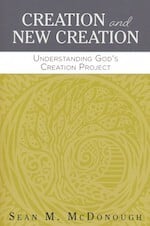Adventures in Being Human
Blog / Produced by The High Calling
"Maybe it’s possible to build a better body, one that doesn’t break or age or die, but is such a body even human anymore, especially if it no longer consists of flesh and blood?" asks Charity Singleton Craig for our series Flesh and Blood.
While the technician moved the transducer around on my chest, I watched the muscles of my heart pumping, the soft tissues flapping in rhythm to the pounding I heard through the machine.
This is my body, revealed to me in surprising clarity. I wasn’t sure what the opening of my abdominal aorta was supposed to look like, but I was mesmerized by the pulsing, the opening and closing, even when I held my breath and tried to make it stop.
This echocardiogram was ordered by my new family physician out of an abundance of caution. Most likely the occasional palpitations I experience are the result of stress or hormonal changes. But still … some mysteries of our bodies are knowable, so my doctor set out to know through a simple doppler study.
The Mystery of Flesh and Blood
Other mysteries of my flesh and blood—the tingling in my feet, the occasional pulling in my abdomen, the rogue cells that organized and developed their own blood supply to become cancer years ago—these are left only to the imagination. “It’s amazing to think about what goes on in our bodies,” my doctor said. And I am amazed and sometimes horrified and often concerned as I feed and clean and clothe and care for this body. I observe its changes through aging, watch its size and shape transform through exercise or the lack, and predict its urges and hungers as though set to a clock.
Then I look around and see the same thing happening among these I call my own flesh and blood, even though we share no DNA. Living with teenagers is like a laboratory experiment of the effects of high doses of hormones. Right before our eyes, my husband and I watch the growth and development of my stepsons: voices change, emotions flare, hair sprouts in new places, joints ache from rapid change, muscles form, skin stretches.
Eternal Life in a Body
Life in a body, though often torturously limited and pain-filled through disease, injury, aging, and overuse, is the only life we humans know. We often complain about and criticize the “bag of bones” we are given, but flesh and blood is no mere metaphor, at least not for our time on earth. We take what we are given, and eventually, what we were given is taken from us, transformed, redeemed, and ultimately resurrected.
We often imagine those new resurrected bodies, the rebuilt flesh and blood, as more spiritual than our current frames which seem only to hold us back. Maybe it’s just the curse we live under, the restriction to dividing cells which eventually err out, that we resist so fervently. We are nostalgic for the Garden of Eden and long for the heavenly bodies we will receive one day; but we do well to remember the incarnation, when God took on flesh, and to remember the value, dignity, and honor he conferred on curse-stricken bodies that amaze and bewilder and eventually die.
Beyond a Metaphor
It’s the body of Christ, the flesh and blood of our Savior, that helps us understand what life in a body is supposed to be like. The God-man Jesus was no mere metaphor, either. His DNA connected him to his mother, but so too, the broken body and spilled blood connected him to his heavenly Father and to us. We become the flesh and blood of Jesus, his kinfolk, because of his life lived in a body. And there is no greater symbol of our connection to him as embodied souls than sharing in the Eucharist, partaking of Christ’s flesh and blood because we are family.
But even with the high honor Christ places on the body through the incarnation, humans have always had a love-hate relationship with their bodies. Recent trends have thrust body modification into the public consciousness—from plastic surgery to body piercings to dramatic transformation through tattoos and implants—but the cultural practices of permanently or semi-permanently altering one’s appearance have taken place over millennia around the world in the form of bound feet, ear and chin implants, neck elongation, and more. And less permanent modifications like weight loss and weight gain, muscle development and muscle atrophy, makeup, Spanx, colored contacts, and hair coloring have resulted in entire industries capitalizing on our frustration with the flesh and blood we’ve been given.
Beyond Average
According to a recent Atlantic article, scientists working in the field of prosthetic limbs and cyborg development are rethinking the human body altogether. “More and more amputees, engineers, and prospective cyborgs are rejecting the idea that the ‘average’ human body is a necessary blueprint for their devices,” writes Rose Eveleth.
What was once an industry bent on replicating the human body exactly, the world of prosthetics has started thinking more creatively about what the human body can be. As technology advances, as engineers start to borrow ideas and designs not just from human biology but from elsewhere, and as prosthetics become less stigmatized, there are all sorts of options opening up. The human body, and what people consider the “normal” human body, can be a whole lot more than what’s biologically possible.
While in the past, amputees and their care providers were asking how to return their bodies to “normal” through prosthetics, they are now moving toward a different standard: “ … how to improve. How to make a limb new, better, stronger, more striking, more beautiful.”
But is there anything more beautiful than the body as it is, even when it’s broken, diseased, or decaying?
A Journey through the Body
In his Guardian essay “Adventures in medicine: ‘I journey through the body every day,’” physician Gavin Francis talks about historical perspectives of flesh and blood and their greater connection to life. “The earliest anatomists saw a natural correlation between the human body and the planet that sustains us,” Francis writes, “the body was even a microcosm—a miniature reflection of the cosmos. The structure of the body mirrored that of the Earth; the four humours of the body mirrored the four elements of matter. There is sense to this: we are supported by a skeleton of calcium salts, chemically similar to chalk and limestone. Rivers of blood wash into the broad deltas of our hearts. The contours of the skin resemble the rolling surface of the land.”
In his general medical practice in Scotland, Francis encounters every type of body in every stage of life. Sometimes he sees patients in perfect bodies, like the baby girl he delivered after a long night of labor or the week-old baby who came to the office with his mother. Both of these encounters are recounted in the Guardian essay. It’s easy to see the miraculous, the beautiful in these bodies.
But Francis seems drawn to other bodies, too, the bodies of people who have lived more of life, who now have stories to tell that accompany their medical crises and confrontations with pain.
Medicine has been my livelihood, but working as a physician has also delivered me a lexicon of human experience—I’m reminded every day of the frailties and strengths in each of us. Beginning a clinic can be like setting out on a journey through the landscape of other people’s lives as well as their bodies. Often the terrain is well known to me, but there are always trails to be broken, and every day I glimpse a new panorama. The practice of medicine is not just a journey through the parts of the body and the stories of others, but an exploration of life’s possibilities: an adventure in human being.
From Death to Life
Maybe it’s possible to build a better body, one that doesn’t break or age or die, but is such a body even human anymore, especially if it no longer consists of flesh and blood?
In 2 Corinthians 4:10-12, the Apostle Paul says that the weakness of living as flesh and blood accomplishes something more for us than perfection and longevity in this life. “We always carry around in our body the death of Jesus, so that the life of Jesus may also be revealed in our body,” he writes. “For we who are alive are always being given over to death for Jesus’ sake, so that his life may also be revealed in our mortal body.”
Christ’s flesh and blood given for our flesh and blood.
Even the resurrection doesn’t mean we are just bodies. We are more, of course, but we are never less than our bodies. We are never less than the soft tissue of heart, the wrinkled lines of skin, the electrical currents of brain. They aren’t always pretty or fully functional or even the size or shape we want them to be, but for better or for worse—and I happen to think for better—our bodies are who we are in and to the world.





